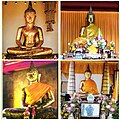
Lotus position or Padmasana is a cross-legged sitting meditation pose from ancient India, in which each foot is placed on the opposite thigh. It is an ancient asana in yoga, predating hatha yoga, and is widely used for meditation in Hindu, Tantra, Jain, and Buddhist traditions.
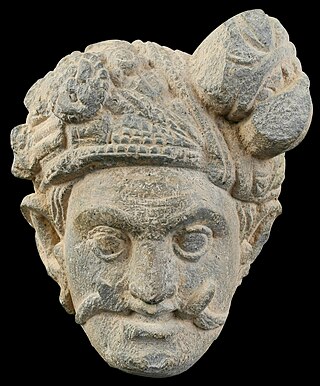
Mara, in Buddhism, is a malignant celestial king who tried to stop Prince Siddhartha from achieving Enlightenment by trying to seduce him with his celestial Army and the vision of beautiful women who, in various legends, are often said to be Mara's daughters.

A mudra is a symbolic or ritual gesture or pose in Hinduism, Jainism and Buddhism. While some mudras involve the entire body, most are performed with the hands and fingers.

Much Buddhist art uses depictions of the historical Buddha, Gautama Buddha, which are known as Buddharūpa in Sanskrit and Pali. These may be statues or other images such as paintings. The main figure in an image may be someone else who has obtained Buddhahood, or a boddhisattva, especially in the various traditions of Mahayana Buddhism. Other Buddhas and bodhisattvas in art have become increasingly common over the centuries, perhaps now outnumbering images of the historical Buddha.
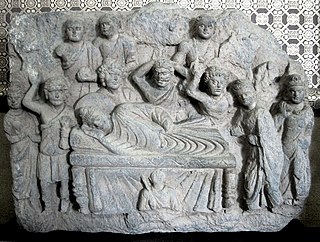
A reclining Buddha is an image that represents Buddha lying down and is a major iconographic theme in Buddhist art. It represents the historical Buddha during his last illness, about to enter the parinirvana. He is lying on his right side, his head resting on a cushion or relying on his right elbow, supporting his head with his hand.

The iconography of Gautama Buddha in Laos and Thailand recall specific episodes during his travels and teachings that are familiar to the Buddhists according to an iconography with specific rules. The Buddha is always represented with certain physical attributes, and in specified dress and specified poses. Each pose, and particularly the position and gestures of the Buddha's hands, has a defined meaning which is familiar to Buddhists. In other Buddhist countries, different but related iconography is used, for example the mudras in Indian art. Certain ones of these are considered particularly auspicious for those born on particular days of the week.

Ajahn Maha Bua was a Thai Buddhist monk. He was thought by many of his followers to be an arahant. He was a disciple of the esteemed forest master Ajahn Mun Bhuridatta, and was himself considered a master in the Thai Forest Tradition. Following the death of Ajahn Thate in 1994, he was considered to be the Ajahn Yai of the Thai Forest Tradition lineage until his death in 2011.

Dhammakaya meditation is a method of Buddhist Meditation developed and taught by the Thai meditation teacher Luang Pu Sodh Candasaro (1885–1959). In Thailand, it is known as Vijjā dhammakāya, which translates as 'knowledge of the dhamma-body'. The Dhammakaya Meditation method is popular in Thailand and other parts of Southeast Asia, and has been described as a revival of samatha (tranquility) meditation in Thailand.

Wat Phra Sri Rattana Mahathat (Thai: วัดพระศรีรัตนมหาธาตุ; "Temple of the Great Jewelled Reliquary"), colloquially referred to as Wat-Phra-Sri or Wat Yai (Thai: วัดใหญ่; "Big Temple"), is a Buddhist temple (wat) in Phitsanulok Province, Thailand, where it is located on east bank of Nan River, near Naresuan Bridge and opposite Phitsanulok Provincial Hall. It is about 337 km from Bangkok.

A Buddha image in Thailand typically refers to three-dimensional stone, wood, clay, or metal cast images of the Buddha. While there are such figures in all regions where Buddhism is commonly practiced, the appearance, composition and position of the images vary greatly from country to country in Buddhist art.

The Golden Buddha, officially titled Phra Phuttha Maha Suwanna Patimakon, commonly known in Thai as Phra Sukhothai Traimit, is a gold Maravijaya Attitude seated Buddharupa statue, with a weight of 5.5 tonnes. It is located in the temple of Wat Traimit, Bangkok, Thailand. At one point in its history, the statue was covered with a layer of stucco and coloured glass to conceal its true value, and it remained in this condition for almost 200 years, ending up as what was then a pagoda of minor significance. During relocation of the statue in 1955, the plaster was chipped off and the gold revealed.

Wat Ong Teu Mahawihan is one of many Buddhist monasteries in the city of Vientiane in Laos. This name is given to the temple due to the large, bronze Phra Ong Teu Buddha image that is in the temple: the largest Buddha in Vientiane. This temple was initially constructed by King Setthathirath I in the 16th century when Laos was being bombarded by the Burmese, but was later demolished during a foreign invasion. Thus, it may have gone through many reconstructions during the 19th or 20th century to attain the appearance it has today.
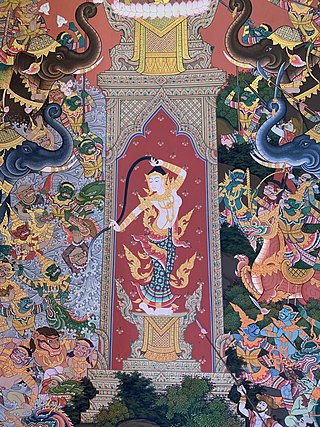
Vasundharā or Dharaṇī is a chthonic goddess from Buddhist mythology of Theravada in Southeast Asia. Similar earth deities include Pṛthivī, Kṣiti, and Dharaṇī, Vasudhara bodhisattva in Vajrayana and Bhoomi devi and Prithvi in hinduism.
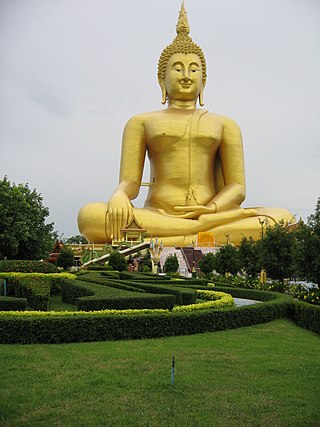
The Big Buddha of Thailand, also known as The Great Buddha, The Big Buddha of Thailand, Phra Buddha Maha Nawamin, and Mahaminh Sakayamunee Visejchaicharn is a statue of the Buddha, located in Ang Thong Province of Thailand. It is the tallest statue in Thailand, the second tallest statue in Southeast Asia, and the ninth-tallest in the world.

Carved elephant tusk depicting Buddha life stories is an intricately carved complete single tusk now exhibited at the Decorative Arts gallery, National Museum, New Delhi, India. This tusk was donated to the Museum. This tusk, which is nearly five foot long, illustrates forty three events in the life of the Buddha and is thought to have been made by early 20th century craftsmen from the Delhi region.

Leela attitude is an attitude of Buddha in Southeast art of which the Buddha is stepping with his right foot and his right-hand swinging and the other hand put towards to the front. The attitude is sometimes called the Walking Buddha.

Māravijaya attitude is an attitude of Buddha in Thai art of which the seated Buddha is putting his hand in the relax posture towards to the ground, loosely holding his knee. The other hand is on his lap. His eyes, sometimes closed, look down to the ground. The gesture of the hand reaching the ground is called bhumisparshamudra, which also refers to the attitude as well. The gesture refers to the episode which the Buddha calling the earth to witness.

Naga Prokattitude (Thai: ปางนาคปรก; RTGS: pang nak prok), translated as "sheltered-by-the-naga Buddha", is an attitude of Buddha in Burmese, Khmer, Lao and Thai art in which the Buddha, seated in either the meditation or maravijaya attitude, is sheltered by or covered with a multi-headed nāga. The nāga, whose name is Mucalinda, usually has seven or nine heads and appeared to coil the base of the Buddha statue.

Narrative images of episodes from the life of Gautama Buddha in art have been intermittently an important part of Buddhist art, often grouped into cycles, sometimes rather large ones. However, at many times and places, images of the Buddha in art have been very largely single devotional images without narrative content from his life on Earth.






